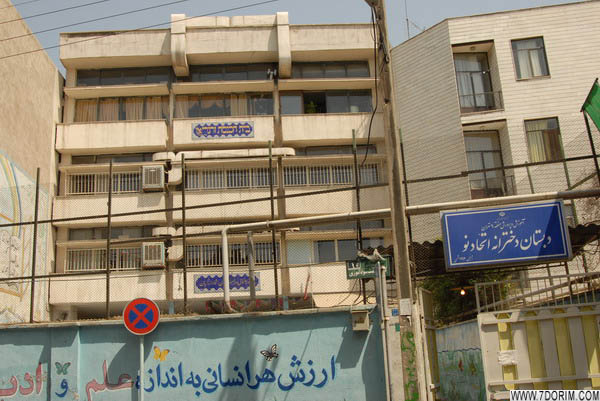Please click to see 360-degree images (panorama).
Northwestern Tehran, the North Amirabad neighborhood, hosts the Zargarian Synagogue and School, the result of the relentless determination of Jewish philanthropist, Abdullah Eliahu Zargarian.
As the Jewish population expanded in the neighborhood, the need for a synagogue to fulfill their religious obligations also grew. This prompted Abdullah Zargarian and his friend in 1971 to consider constructing a synagogue together.
They found a suitable land on the southern side of Elizabeth Blvd. (currently known as Keshavarz Blvd.). Abdullah Zargarian paid the deposit for the contract and, along with Musa Berlavi, Ismail Khodadadi, and Musa Sasooun, immediately began efforts to secure funds for the synagogue’s construction from Jewish organizations and philanthropists. The Tehran Jewish Committee embraced the proposal and committed to offering assistance to the fullest extent possible. Monsieur Kohenka, the director of the Alliance Institute in Iran, also pledged to provide important material and spiritual assistance to Mr. Zargarian provided he builds an Alliance School there.
After the agreement, the plan to create the cultural complex project was put to competition among the architects of the community. After 45 days, the three submitted plans were sent to the Alliance Center in France. After 2 months, the three-phase plan designed by Engineer Manouchehr Kohen was selected as the best plan. Construction of this cultural complex began in the late 1970s under the direct supervision of Abdullah Zargarian. After 18 months, in September 1973, it was officially inaugurated at the Yom Kippur ceremony with the presence of over 450 of the community’s residents from the areas of Amirabad, Elizabeth Boulevard, Gisha, and Jannatabad. The design of this complex was calculated and executed in five floors with modern materials and engineering methods, in a metallic form with concrete foundation and roof, and with the observance of the maximum seismic safety factor.

The Zargarian Synagogue
The design, calculation, and execution were carried out on an entirely honorary basis by Manouchehr Kohen Engineering Company, in collaboration with other experienced engineers of this company, including Engineer Houshang Hassidim. All construction operations throughout the 18 months from start to finish were personally supervised by Engineer Manouchehr Kohen as the consulting engineer. He not only had direct oversight over all project operations but also had direct supervision from other aspects, particularly in the selection of construction materials and quality control of production.
The synagogue was built on the northern side of the plot while the southern side was dedicated to the school’s yard. In accordance with the cultural and religious building style, the entrance door leads directly from the south side to the courtyard, then to the building.
Specifications of the complex:
- The mid-basement floor included a residential unit for the caretaker, which was designed to benefit from direct sunlight despite its location.
- The ground floor included a playground with two covered sections and one outdoor yard.
- The first floor included the office and restrooms.
- The second floor included the primary school, with six classes, each with a capacity of 35 to 40 pupils. This floor also had an office and restroom.
- The third floor was dedicated to a high school with six classes, each with a capacity of 35 to 40 students. It also had an office and restroom.
- The fourth floor included the synagogue with a capacity of 450 people.
The Zargarian Synagogue is part of a larger educational building. Although the interior design of the synagogue is simple from an architectural standpoint and lacks any specific traditional features, by creating differences in the construction method and borrowing from recognized details in modern architecture, it has been somewhat influenced by the design of the original building. The Torah ark in this synagogue is beautifully decorated with fine woodwork, and the prayer hall has been formed by organizing and arranging the interior elements, such as the seating areas, the prayer leader’s platform, the Torah ark, and the chandeliers. The women’s section is located at the back of the hall, as is the case in most synagogues, and an air conditioner and an elevator for the elderly have been installed in this section.
Since its establishment, the rabbis of the synagogue include: Khanbaba Pedu’im, Shemuel Khodadadi, Yaghoub Hanokai, Musa Khatani, Mirzadeh Yaghoub Banafsheh, Yaghoub Setareshenas,Mehran yaghoubi, Eshagh Hazab, among others. Mr. Abdullah Daghighian was selected as the first principle of this school by the Alliance headquarters. He successfully executed his duties in this position for ten years. It is worth mentioning that Mr. Abdullah Zargarian was in charge of the project for the entire 18 months of construction. He personally took care of all financial and administrative expenses, including the procurement of construction materials, the selection of all construction contractors, foundation specialists, structural engineers, roof contractors, etc. In recognition of his invaluable services and contributions, the synagogue within this cultural complex was named after him. This decision was made by the synagogue council and approved by the Jewish Committee.

The Zargarian Synagogue
Summer 2009

Zargarian Synagogue
Summer 2009

Zargarian Synagogue
Summer 2009

Zargarian Synagogue
Summer 2009

Zargarian Synagogue
Summer 2009

Zargarian Synagogue
Summer 2009

Zargarian Synagogue
Summer 2009

Zargarian Synagogue
Summer 2009

Zargarian Synagogue
Summer 2009

Zargarian Synagogue
Summer 2009

Zargarian Synagogue
Summer 2009

Zargarian Synagogue
Summer 2009

Zargarian Synagogue
Summer 2009

Zargarian Synagogue
Summer 2009

Zargarian Synagogue
Summer 2009

Zargarian Synagogue
Summer 2009

Zargarian Synagogue
Summer 2009

Zargarian Synagogue
Summer 2009

Please click to see 360-degree images (panorama).


 فارسی
فارسی